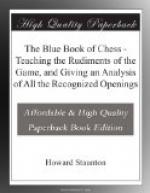{PGN 70}
[Event “?”] [Site “?”] [Date “????.??.??”] [Round “?”] [White “Marshall, Frank J.”] [Black “Janowsky, D.”] [Result “1-0”] [ECO “D63”] [Annotator “The Blue Book of Chess, p. 190.”] [PlyCount “69”]
1. d4 d5 2. c4 e6 3. Nc3 Nf6 4. Bg5 Nbd7 5. Nf3 Be7 6. e3 O-O 7. Rc1 {Marshall abandons his favorite variation Qc2.} Re8 {Janowsky also changes c5, played in the earlier games.} 8. Bd3 dxc4 9. Bxc4 a6 {Janowsky’s favorite manoeuvre, which might have been expected. Therefore Marshall could have played cxd4 previous to Bd3.} 10. O-O {a4 would have prevented the Bishop being dislodged; but as he manages eventually to prevent Black from keeping the majority of Pawns on the Queen’s side, there is nothing to be said against it—except that he only keeps about an even game.} b5 11. Bd3 Bb7 12. Qe2 c5 13. dxc5 {This is compulsory, because of the threat c4, followed by b4.} Nxc5 14. Bc2 {Bb1 might be followed by b4, when Qe1 would take up the place which the R at f1 intends to occupy; but the move would have been better, nevertheless.} Nd5 15. Bxe7 Qxe7 16. Nxd5 Bxd5 17. b3 Rac8 18. e4 Bb7 19. b4 {It is doubtful whether the advance might not have been dispensed with, because of the threat Nd7, Nb6, and Nc4 eventually. But Marshall plays still for attack, not content with a draw in an even position.} Nd7 20. Rfd1 Nf8 21. a3 Rc3 {Black has now the better game.} 22. Bd3 Rec8 23. Rxc3 Rxc3 24. Qb2 Rc8 {Notes By L. Hoffer.—Qc7 could be played here.} 25. Rc1 Rd8 ({An alternative would be} 25... Qf6 26. e5 Qd8 27. Rxc8 Qxc8 28. Qc2 Qxc2 29. Bxc2 Nd7 {winning the King Pawn.}) 26. Bb1 Nd7 {Qd6 or Qc7 could be played. The text move gives White a chance to bring his Queen effectively into play.} 27. Qd4 Nf6 28. Qe5 Ng4 29. Qf4 Nf6 30. h3 Ne8 31. Ne5 Nd6 32. Ng4 Nc4 {Ne8 would have been safer.} 33. e5 Kh8 34. Nf6 gxf6 {Marshall did not expect this complaisance, and Janowsky would not have obliged him had he seen the fatal 35. Qh4. 34...Nxe5 should have been played.} 35. Qh4 {Marshall risked losing the game in trying to win. His boldness was rewarded, but the verdict should be: Don’t try it again.} 1-0
{PGN 71}
[Event “?”] [Site “?”] [Date “????.??.??”] [Round “?”] [White “Lasker, Dr.”] [Black “Tarrasch, Dr.”] [Result “1-0”] [ECO “C12”] [Annotator “The Blue Book of Chess, Game I., p. 199.”] [PlyCount “55”]
1. e4 e6 2. d4 d5 3. Nc3 Nf6 4. Bg5 Bb4 5. exd5 Qxd5 6. Nf3 {The best line of play against the McCutcheon defence. It was played in a game Sjoberg vs. Giersing, Stockholm, 1906.} c5 {Out of place in this position. Nd7 or Ne4, would be alternatives—the former move in preference.} 7. Bxf6 gxf6 8. Qd2 Bxc3 9. Qxc3 {This excellent move was probably not taken into consideration by Tarrasch when advancing c5.} Nd7 10. Rd1 Rg8 ({If} 10... cxd4 11. Rxd4 {and Black could not challenge the Queen with} Qc5 {because of} 12. Bc4) ({Nor could} 10... Ke7 {be played, because




